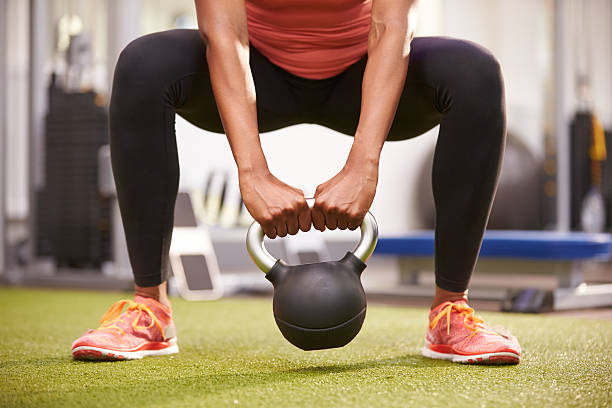Kettlebell Front Squat
The kettlebell front squat is a great alternative to the traditional barbell squat.
If you’re encountering lower back issues or want to place greater emphasis on the quads as opposed to the hamstrings I recomend adding the kettlebell front squat into your routine.
Movement: Compound
Targets: Quads, Hamstrings, Glutes, Calves, Core
Required: Kettlebells
Optional: N/A
Kettlebell Front Squat Form:
Load two kettlebells to your shoulders (drive through your legs and raise the kettlebells towards your shoulders while rotating your wrists).
With the kettlebells in place proceed to squat down as low as possible, maintain an upright torso and continue to look forward.
Drive through your heels to raise yourself back up.
Kettlebell Front Squat Variations
Kettlebell Goblet Squat
The kettlebell goblet squat utilizes one kettlebell held infront of the chest in the rack position as opposed to two kettlebells held in the rack position.
Here Are The Kettlebells I Use & Highly Recommend…
Rep Fitness kettlebells are super high quality and affordable, I’ve used some of the big name companies kettlebells and coming in at double the price the quality is identical to that of the highly affordable Rep range of kettlebells. Invest in a high qualtity kettlebell or two that’ll stand the test of time.
Common Kettlebell Front Squat Mistakes
Skipping Squats
If I had to choose only 3 exercises to perform for the rest of my days in the gym, the squat would be one of them. Needless to say the traditional barbell squat is the best lower body exercise in existence. The barbell back squat when performed correctly will hit your quads, hamstrings, glutes and calfs, and unlike machine based exercises such as the leg extension the barbell squat can safely be performed with heavy weight – allowing us to continually apply progressive overload and build up strong, functional legs.
The leg press, leg curls, leg extensions, dumbbell lunges… all of these exercises come second to the squat.
The squat has stood the test of time and should be included in every leg workout, with many different variations (based on foot placement and bar placement).
When training legs, strict form and a full range of motion must be utilized to activate and overload the muscles being targeted.
Squat half reps, a minuscule leg press range of motion, not dropping your knee low enough on dumbbell lunges… if you’re constantly limiting your range of motion you’re not going to be able to build either the size or strength you’re chasing.
Lifting Too Heavy
When squatting or using the leg press ‘getting out of the hole’ aka. the bottom portion of the movement is without a doubt the hardest. If you’re performing half reps because you’re unable to get the weight out of the hole it’s a clear sign you’re lifting too heavy. Stacking more and more weight on the bar or the machine may make you feel good… but you won’t see that weight translate into size or strength gains. Check your ego at the door and lift weight which you’re able to manage (while still being a challenge in the prescribed rep range) utilizing a full range of motion.
Poor Mobility
If you’re new to the gym and you’ve spent the last decade working in an office day in day out chances are your mobility isn’t the greatest. Constant practise combined with stretching, foam rolling and a mobility routine will have you getting low on those squats in no time, tight hip flexors (from sitting all day) are notorious for this.
Laziness
There’s nothing pretty about dropping your ass to the grass with 350lbs on your back, multiple times at 5am in the morning. But the feeling of accomplishment, constant progression, mental fortitude and discipline it builds is worth it.
Squatting heavy with a full range of motion sucks, but if you’re using the right weight and you’ve developed the mobility to work a full range of motion you have no excuse.
Similar & Substitute Exercises
- Goblet Squat
- Pistol Squat
